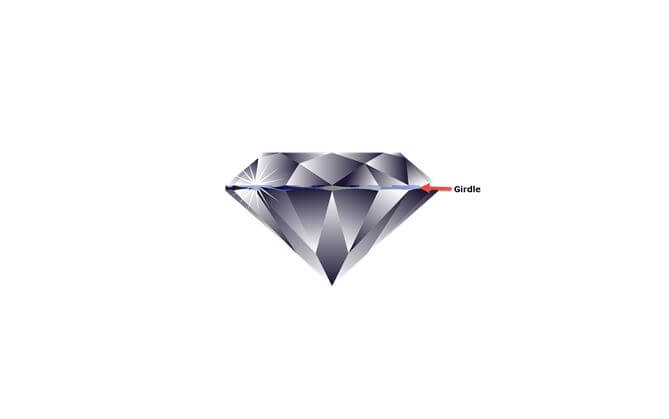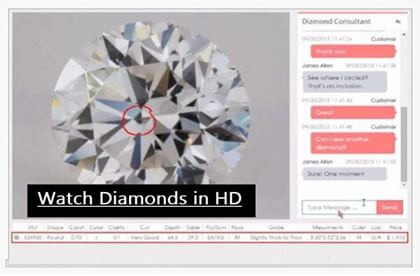Executive Summary
The part of the diamond that divides the crown of the diamond from the pavilion of the diamond is the girdle. It is the circumference and outermost part of the diamond that is in contact with the setting of the diamond. The girdle of a diamond can either be rough (unpolished), polished and faceted or polished and unaffected.
The thickness of the girdle is very important as it affects the diamond a lot. You must watch out for the two extremes. The diamond girdle must not be extremely thick because it results in dead weight and makes the diamond smaller than it should be. The other extreme is the extremely thin girdle. This increases the risk of chipping along the edge of the diamond especially when the diamond is being set or even while it is worn.
According to the GIA, the girdle of a diamond can also be rated based on its thickness. There are 8 different grades on the girdle rating scale. Extremely thin, very thin, thin, medium, slightly thick, thick, very thick, extremely thick are the different classes for a diamond girdle.
During the process of diamond grading, different points along the diamond’s girdle are measured to determine the thinnest and thickest points. Most often, diamond girdles are rated as a range e.g. thick to very thick. The reason for this is to accommodate the difference between the thinnest point and the thickest point. The variation in the girdle thickness must be watched carefully. You must watch out for diamonds with extreme and bizarre girdle thickness variation, e.g. extremely thin to very thick. The issue with diamonds like this is that they are an indication of a poor diamond cut and poor diamond symmetry. These diamonds usually have poor optical performance, so it is best to avoid them.
The girdle of a diamond is the part of the diamond that divides the crown of the diamond (above it) from the diamond’s pavilion (below it). When you look through the profile view of a diamond, the widest part of a diamond, which is also the circumference of the diamond is the girdle. When the diamond is viewed in its setting, it is also the part of the diamond that is in contact with the diamond’s setting. In short words, it is the outermost edge of a diamond. All diamonds have a girdle and it is important in a diamond because it reduces the possibility or risk of the diamond getting damaged when the jewelers work on the diamond. The girdle of the diamond is also measured in order to get the measurement of a loose diamond (the length and width of the diamond measured in millimeters).
The girdle of a diamond can either be rough (unpolished), polished and faceted or polished and unfaceted. The girdles of brilliant-cut diamonds are usually faceted. The facet is triangular in shape rather than being perfectly round. This is what gives the brilliant diamonds the high measure of transparency that they usually have. The girdles of step cut diamonds are usually polished but they are not faceted. These diamonds usually have different rows of elongated facets.
Grades of Girdle
Like many other attributes of the diamond, the diamond girdle also has a grading scale. During the process of diamond grading, different points along the diamond’s girdle are measured to determine the thinnest and thickest points. The rating or grade of diamond girdle ranges from extremely thin to extremely thick. Most often, diamond girdles are rated as a range e.g. thick to very thick. The reason for this is to accommodate the difference between the thinnest point and the thickest point. But if the two points are in the same category, the girdle is given a single rating.
The different grades of the diamond girdle are as follows:
- Extremely thin: This girdle is very small and almost invisible. You have to take extra care when setting the diamond as well because it is more prone to breaking or chipping. The diamond depth will most likely be shallow. It may also significantly affect the cut grade of the diamond.
- Very thin: This girdle is thin but a very good proportion for diamonds but you have to take extra care when you are setting the diamond because there is also a risk of chipping in the diamond. A diamond with a very thin girdle can’t have an excellent cut grade. The diamond depth may as well be shallow.
- Thin: This is also a good proportion of diamonds. But it is not the best for fancy shape diamonds as they are more prone to chipping. So having a thin girdle might not be enough to protect the diamond from chipping. Fancy diamonds with this girdle grade have to be handled carefully when setting the diamond.
- Medium: This is an ideal proportion of diamonds. This girdle grade is perfect. It does not adversely affect the cut grade of the diamond and the diamond is also not prone to chipping. The diamond depth is also not too deep in these diamonds.
- Slightly thick: This is also an ideal proportion of diamonds. The girdle grade of the diamond is near perfect. It does not adversely affect the cut grade of the diamond and the diamond is also not prone to chipping. The diamond depth is also not too deep in these diamonds.
- Thick: This girdle is thicker than required but it is still good for diamonds. Although it may cause the diamond’s depth to slightly increase, it results in a very good diamond cut grade most times.
- Very thick: This girdle is much thicker than required for a diamond. It results in high diamond depth and may reduce the cut grade of the diamond from very good to good. It is also possible to see the reflection of the girdle within the diamond.
- Extremely thick: This girdle is too thick for a diamond and may make the diamond to be smaller than it should be because the girdle will take up more depth than it should. It can affect the symmetry of the diamond and may also reduce the cut grade of the diamond. It mostly results in what is known as the “fisheye” effect where the reflection of the diamond’s girdle is seen in the diamond and this adversely affects the sparkle of the diamond.
Importance of the Diamond Girdle Thickness
You must make sure that you lookout for the extremes of the diamond girdle. The diamond girdle must not be extremely thick because it results in deadweight and makes the diamond smaller than it should be. When the diamond is cut to ideal proportions, the diamond will show great fire and brilliance if the girdle is extremely thick. The only problem is the concentration of the weight of the diamond in the middle. An extremely thick diamond girdle might as well not significantly impact the perceived size of the diamond if the measurement of the diamond is ideal or within that range. That is why the overall measurement of the diamond is taken into consideration when determining the impact of the extremely thick girdle.
Another extreme to watch out for is the extremely thin girdle. This increases the risk of chipping along the edge of the diamond especially when the diamond is being set or even while it is worn. You must ensure the diamond is protected in the setting in a way that it does not make contact with an abrasive surface. In diamonds with extremely thin girdle thickness, the pavilion facet and the crown meet at a facet junction known as the knife edge. This knife edge is known to be the weakest point of the crystalline structure of the diamond and is the part of the diamond that is most susceptible to damage.
Although it was noted earlier that diamond girdle is rated in a range to accommodate variation along with different points of the girdle. You must watch out for diamonds with extreme and bizarre girdle thickness variation, e.g. extremely thin to very thick. The issue with diamonds like this is that they are an indication of a poor diamond cut and poor diamond symmetry. Diamonds like this usually have a poor optical performance. These bizarre variations can also result in some problems during the process of setting the diamond.
Diamonds that have extremely thin or extremely thick girdles are usually priced lower than other diamonds that have ideal girdle ratings. This can offer a great financial advantage to the customer. You must, however, be careful when purchasing such diamonds. You might require it is visually inspected by a professional to ascertain if it is good enough for you to buy or not.
Buyer’s Guide for a Diamond’s Girdle
The girdle of a diamond is not something of a priority when buying a diamond. It is not something that is put under serious consideration because the thickness or thinness of a diamond’s girdle does not necessarily affect the overall appearance of the diamond if the diamond is cut to ideal proportions. However, when considering the symmetry of the diamond, the variation between the thinnest and the thickest point of the diamond’s girdle is considered. If the range of the variation of the thickness on various points on the girdle is extremely wide, the diamond will appear disproportioned. So as much as possible, you should pay attention to the symmetry of the diamond on the diamond certificate before purchasing the diamond.
If you are looking for an ideal cut diamond, the recommended girdle rating is between thin to thick. The most perfectly proportioned diamonds usually have a girdle rated medium. Although, other diamond girdle ratings close to the medium are also considered as ideal for diamonds.
If you are buying a round brilliant cut diamond, the range for the diamond’s girdle should be between thin – medium – slightly thick. So if you see a round diamond with girdles ranging from thin – slightly thick or thin – medium or medium – slightly thick girdle, it is okay to go ahead and purchase them.
If you are buying fancy shape diamonds like pear, heart, marquise, the girdle thickness should range from thin – medium – slightly thick – very thick. So if you find a fancy diamond with thin – medium, medium – slightly thick – slightly thick – very thick girdles, it is recommended that you purchase them given that the diamond is well cut. It is okay for fancy shape diamonds to have very thick girdles, especially at the pointed edges of the diamond. This extra thickness at the edges will provide the diamond with additional strength which will help to protect the diamond from chipping at the edges. So, as long as the diamond is well cut, a very thick girdle is an added advantage for fancy diamonds.
As we have mentioned earlier, the girdle is not the most important thing to look out for when buying a diamond. The 4Cs remain the first criteria to check. The cut of the diamond is the most important, the quality of the diamond’s cut and the light performance of the diamond should always come first.




